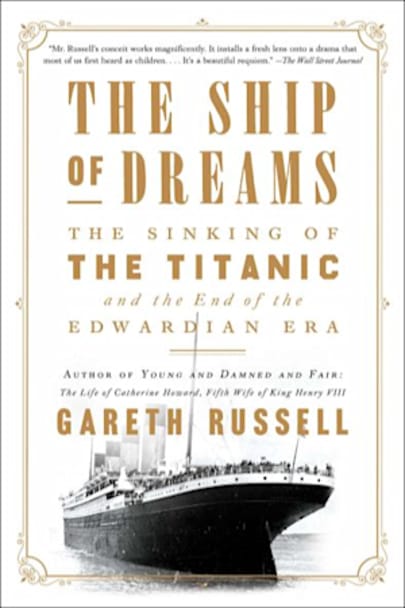This original and “meticulously researched retelling of history’s most infamous voyage” (Denise Kiernan, New York Times bestselling author) uses the sinking of the Titanic as a prism through which to examine the end of the Edwardian era and the seismic shift modernity brought to the Western world. “While there are many Titanic books, this is one readers will consider a favorite” (Voyage). In … favorite” (Voyage).
In April 1912, six notable people were among those privileged to experience the height of luxury–first class passage on “the ship of dreams,” the RMS Titanic: Lucy Leslie, Countess of Rothes; son of the British Empire Tommy Andrews; American captain of industry John Thayer and his son Jack; Jewish-American immigrant Ida Straus; and American model and movie star Dorothy Gibson. Within a week of setting sail, they were all caught up in the horrifying disaster of the Titanic’s sinking, one of the biggest news stories of the century. Today, we can see their stories and the Titanic’s voyage as the beginning of the end of the established hierarchy of the Edwardian era.
Writing in his signature elegant prose and using previously unpublished sources, deck plans, journal entries, and surviving artifacts, Gareth Russell peers through the portholes of these first-class travelers to immerse us in a time of unprecedented change in British and American history. Through their intertwining lives, he examines social, technological, political, and economic forces such as the nuances of the British class system, the explosion of competition in the shipping trade, the birth of the movie industry, the Irish Home Rule Crisis, and the Jewish-American immigrant experience while also recounting their intimate stories of bravery, tragedy, and selflessness.
Lavishly illustrated with color and black and white photographs, this is “a beautiful requiem” (The Wall Street Journal) in which “readers get the story of this particular floating Tower of Babel in riveting detail, and with all the wider context they could want” (Christian Science Monitor).
more



This absorbing account proves that there are many levels to the endless fascination of the Titanic story; the key is to narrow the focus rather than try to be all-embracing. Thus, through his judicious choice of a handful of socially and culturally disparate passengers, Gareth Russell skillfully constructs an eloquent and gripping narrative that is essentially a microcosm of the moribund Edwardian class system that would go down with the Titanic and finally be obliterated by war in 1914.
Gareth Russell invites us into the first-class staterooms aboard the RMS Titanic and brings to life the Edwardian era and its elite—the exclusive circle of Europeans and Americans who wielded unimaginable wealth and influence on both sides of the Atlantic. Deeply researched and lushly detailed, The Ship of Dreams shines new light on both the bygone Golden Age and the iconic tragedy that marked the beginning of its end.
When I saw this offered I debated a bit about requesting a copy because so much has been written about Titanic that the thought occurred to me about what could [possibly be new in this book. I’m glad I requested it because the answer is a resounding yes, there is more to learn about the Titanic. From the days of construction to her final hours, the point of view in this impressive and entertaining historical book, the reader follows various passengers on their voyage into history.
The world is changing and World War One is fast approaching and seeing these last days through the lives of an actress, Dorothy Gibson, Lucy Leslie, Countess of Rothes; American tycoon John Thayer and his son; British aristocrat Tommy Andrews; and Ida Straus, a Jewish-American immigrant. By weaving their stories with the Titanic and the world as they knew it and what it was becoming, this is a masterful story that brings history alive in incredible detail. Yes, there is a fresh way of looking at the Titanic, there is new information and I enjoyed the time it took me to read every word. It was never dull or dry as so much history can be. This history came alive with his wonderful writing style, placing the reader on the decks, in the lavish cabins and into a new world in the making.
4 stars
I have been a follower of all things Titanic for many years and found this book to be a welcome addition to my collection. Mr. Russell manages to put the ship and its passengers into a complete historical perspective. He shows that we are all “victims” of our social class and of the time in which we live.
This book is a very good re-telling not only of the Titanic tragedy, but also Mr. Russell includes brief but very detailed biographies of some of the famous personages included in his book. The research alone must have been exhaustive and extensive. In addition, he included the political climate in Belfast and the rest of Ireland where the Titanic was built as well as both the political and social climate of Europe and America.
Thus the conditions in Europe and America were masterfully described in what Russell describes as the end of the Edwardian era.
The author also debunks the popular conspiracy theories about the sinking of the Titanic and the rumors that followed some of the passengers – both dead and alive – around like smelly little black clouds especially Mr. Ismay and Mr. Thacker. Their stories were tragic when piled upon their survival but for vastly different reasons.
There is also a copious bibliography and extensive notes for those who would like to further explore Titanic. I watched a documentary recently and read articles about how quickly Titanic is now deteriorating on the seabed. Another sad chapter for the old girl.
Very well done, Mr. Russell. I very much look forward to reading more from this author.